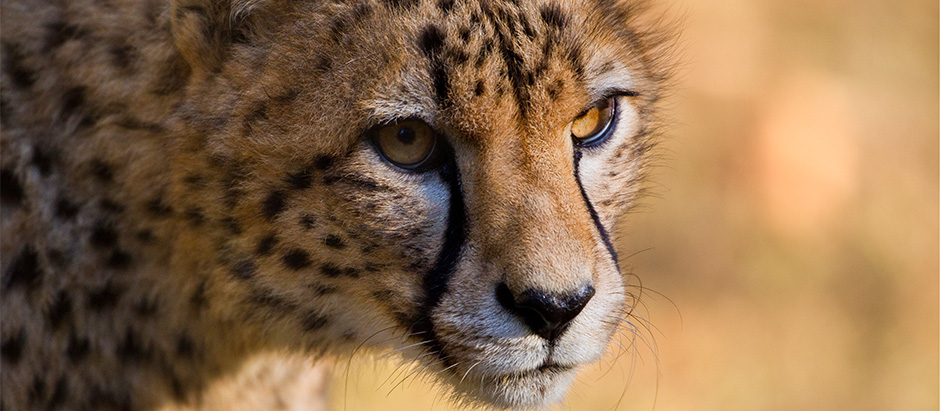Chetah Taxonomy
Kingdom: Animalia
Phylum: Chordata
Course: Mammalia
Social club: Carnivora
Family: Felidae
Subfamilies
The Felidae family consists of 2 subfamilies (Pantherniae and Felinae) and iv extant genera (Felis, Neofelis, Panthera, and Acinonyx) and 38 species.
Subfamily: Pantherinae
Panthera includes lions, tigers, jaguars, and leopards.
Cats in this grouping have the ability to "roar" but non "purr". (See "Purring" vs. "Roaring" Cats section in Communication.)
Roaring occurs due to "ossified hyoid and both divided and undivided vocal folds". This statement refers to the twiglike hyoid bones in the neck that help to anchor the tongue in place. These larger-sized cats take tongues farther secured in place with a longer length of tough cartilage that begins at the hyoid basic and ends in the skull. This prevents a member of Panthera from purring but is flexible enough to allow their larynx the ability to roar.
Near in this family prefer to make other sounds (snarling, hissing, grunting, yowling, coughing) — the king of beasts is the but Panthera fellow member that roars regularly.
Subfamily: Felinae
Felinae includes all non-roaring cats (cheetah, lynx, bobcat, caracal, puma, angling true cat, ocelot, margay, jaguarundi, and serval).
Cats in this grouping have the ability to "purr" but not "roar". (See "Purring" vs. "Roaring" Cats section in Advice.)
Purring occurs due to "imperfect ossified hyoid and undivided vocal folds". This argument refers to the twiglike hyoid bones in the neck that assistance to ballast the natural language in place, which, when combined with a Felinae's power to vibrate its larynx, produces a purring sound.
No 1 knows why those in this subfamily developed the ability to purr, but one theory suggests the female parent Felinae began to purr to aid mask and camouflage the mewing sounds her vulnerable kittens made during nursing.

The serval (Leptailurus serval) is in the subfamily Felinae with the cheetah.
Genus, Species
Genus: Acinonyx
The cheetah is the only cat species in this genus as they are the only blazon of Felidae that cannot fully retract its claws.
Species: jubatus
Subspecies
There are five recognized chetah subspecies:
A. j. hecki: Northwest Africa
A. j. fearsoni: Eastward Africa
A. j. jubatus: Southern Africa
A. j. soemmerringi: Northeast Africa
A. j. venaticus: Northward Africa to key India
"Cheetah" is derived from the Hindi discussion Chita, pregnant "spotted one".
Acinonyx means "no move hook" in Greek — a reference to its non-retractile claws.
The hair on a chetah is longer on the nape than elsewhere — this feature is more visible on cubs every bit the mane is more pronounced and extends over the head, cervix, and back. The discussion jubatus means "mane" or "crested" in Latin — probable this is in reference to the mane found on cheetah when they are cubs.

Fossil Record
An explanation for the speed of the pronghorn may have been the presence of cheetah species which would accept hunted so at ane time on the N American continent.
Recent detailed Dna studies shows evidence that all living cats can be traced dorsum to panther-like predators that existed in Southeast Asia 10.viii million years ago.
In one case considered alone in divide subfamily, cheetahs take now been grouped with pumas (Puma concolor) and jaguarundis (Puma jagouaroundi) according to detailed Dna analysis. This group diverged some six.9 million years ago.
It is believed that the cheetah may have originated in N America before spreading to Eurasia and Africa. Pronghorns, the fastest fauna in North America, reaches speeds of upwardly to 60 mph — far faster than any living Northward America predator including coyotes, wolves, and pumas. One explanation to their superior speed is that such dispatch was needed against the threat of previous North American cheetah species, which likely hunted them in the past.
Ii extinct chetah-similar cats are known to have existed in North America — Miracinonyx inexpectata and Thousand. trumani. Based on a nigh consummate skeleton found at Hamilton Cave, Westward Virginia, M. inexpectata was larger than A. jubatus and had fully retractable claws. Based on hundreds of bones found at Natural Trap Cavern in Wyoming, Yard. trumani was larger only like to A. jubatus.
The oldest cheetah fossils, found in eastern and southern Africa, are approximately iii.5 to 3 meg years old. Early fossils of A. jubatus were discovered in Northern Tanzania, Africa. A. jubatus is believed to have existed three meg years ago, roughly the same time as the now extinct Acinonyx pardinensis, an Eurasian chetah species that was approximately the same size as today's panthera leo species (King of beasts).

0 Response to "Cheetah Kingdom Phylum Class Order Family Genus Species"
Post a Comment